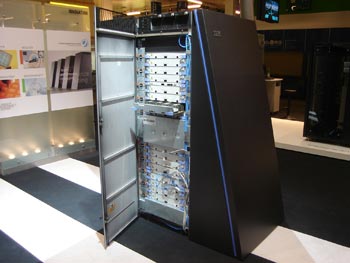Europe's most powerful supercomputer launched

A German research centre has begun operating what is though to be Europe's most powerful computer.
The Jülich Research Center has deployed a system based on IBM's Blue Gene. Jülich's supercomputer, called Jülicher Blue Gene /L (JUBL), consists of eight Blue Gene racks.
This gives JUBL a total of 16,384 processors, and a maximum processing speed of 45.6 teraflops, which would have put it in fifth place in the global supercomputing Top500 when the list was last updated in November, 2005.
Speaking at the CeBIT trade show in Hanover last week, Dr Thomas Lippert, head of the Jülich Research Centre, explained that JUBL will be used to tackle major scientific problems.
Lippert said that the sheer power of JUBL would allow it to handle intensive tasks such as modelling protein folding or the behaviour of liquids or gases.
"We can model trace gas concentrations, or monitor the damage to the ozone layer over the Arctic," explained Lippert. "We can also use it to understand the nanostructure of new chips, and develop new materials for data storage."
Lippert couldn't say how much JUBL had cost, other than it was less than €10m (£7m).
According to Lippert, up to five projects can run simultaneously on the supercomputer. Scientists from across Europe can now apply to have their projects run on JUBL, and Lippert hopes that the supercomputer will give a boost to scientific research in Germany and beyond.
"We want the brain drain to flow into Germany, rather than towards the US, and we hope that the whole of Europe can benefit," said Lippert.
The largest non-secret supercomputer in the world is Blue Gene/L, which is based at the Lawrence Livermore National Laboratory in California. Blue Gene/L has achieved a processing speed of 280.6 teraflops, thanks to its 65,536 processors.

IBM brought a Blue Gene rack to CeBIT to give visitors a sense of the power of the machine